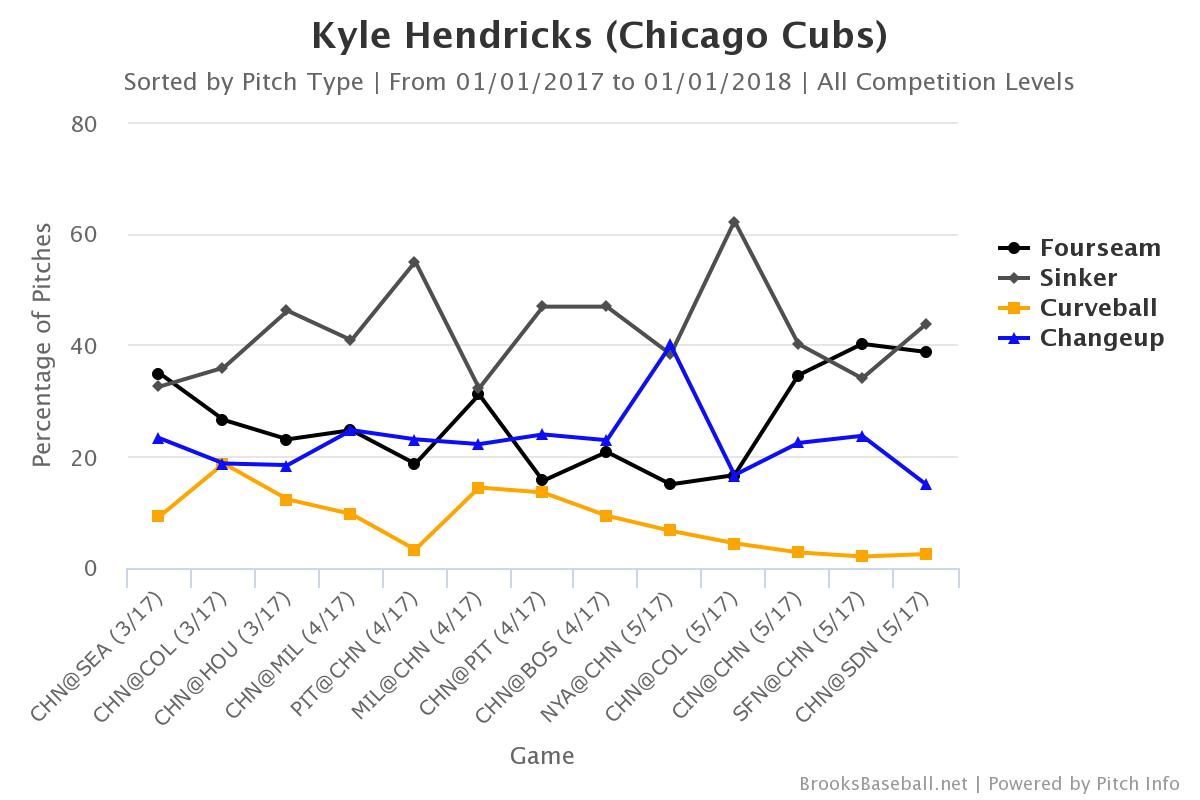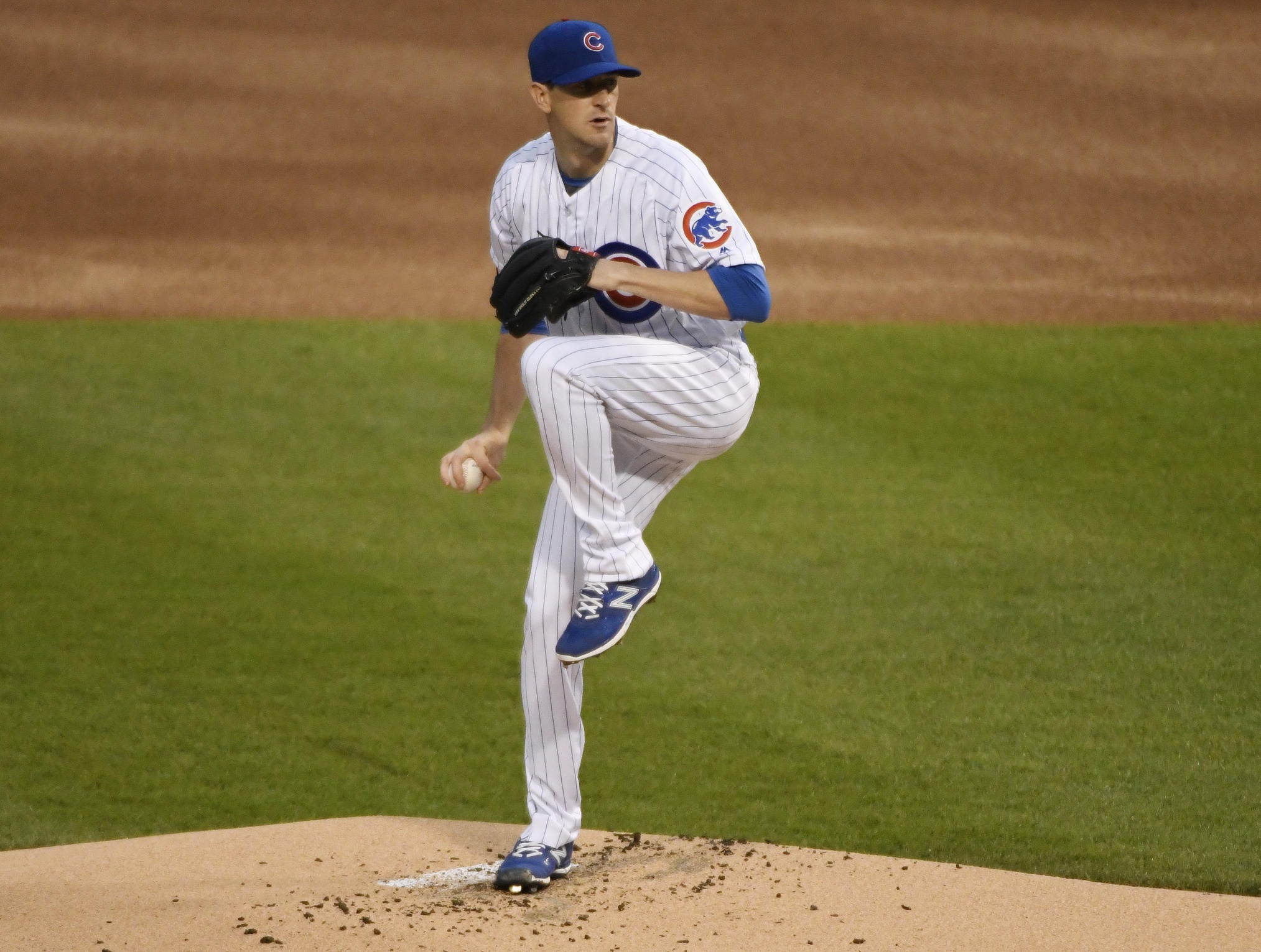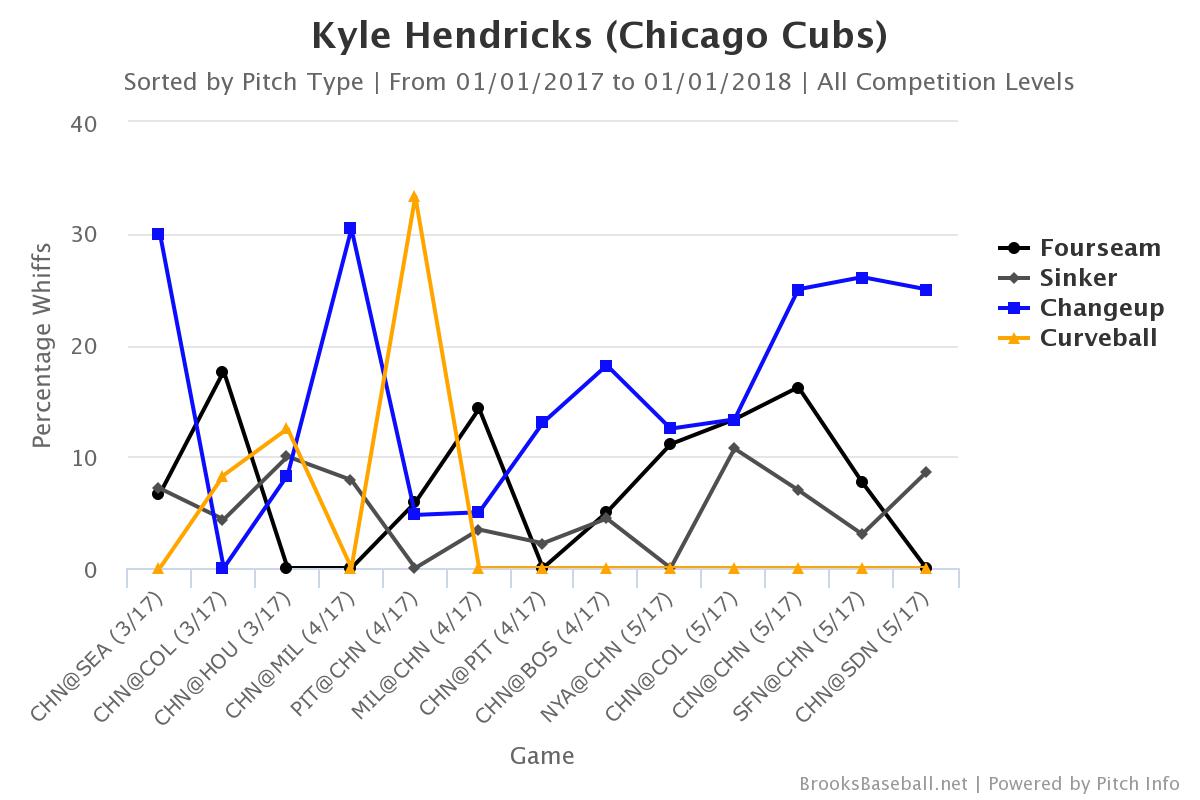For the first month or so of the season, I felt like I had tabs open on Brooks Baseball for each of the Cubs’ starters just about every day. Deciphering the velocity dips, sifting through the useful data, searching for explanations for general ineffectiveness: it was the obsession of someone who desperately wants something to be solvable. Or, of someone who wants it to just be an illusion, the product of luck and radar configuration and weather.
Much of that concern developed from observing Kyle Hendricks’ lackluster start. His first three starts featured run tallies of four, three, and four, but in six, five, and five innings respectively. Not disastrous outings, no—but a far cry from Hendricks’s top-three Cy Young finish and ERA title of 2016. His ERA was unsightly, his velocity was down, and he was walking a handful of batters each start. With the Cubs scuffling, it was easy to point at Hendricks and conclude that he was a cause.
With another month in the books, the Cubs are still struggling. But Hendricks’ performance has helped keep the Cubs from scraping the bottom. He’s improved his ERA in every start since April 19, save his most recent outing in San Diego, and he’s walked six in his last five starts after walking 12 in his first five. Despite the five runs he allowed on Memorial Day, due mostly to a grand slam on one poorly placed pitch, he walked none for the second start in a row. Hendricks is good again; I want to know why and how.
Some of it stems from his pitch selection. Overall, Hendricks is eschewing his changeup and continuing to throw his four-seamer at the higher rate that he began last season. Against both lefties and righties, his changeup percentage in all counts is down five points. His mix versus righties hasn’t changed much, besides a smidge fewer changeups and sinkers. Versus lefties, however, he’s throwing fewer sinkers, fewer changeups, and fewer curveballs—but more four-seamers than he’s thrown against lefties in his career. Mostly, those four-seamers are coming when the batter is ahead in the count, but even when he’s ahead in the count, he has turned to it more often. Importantly, his changeup has been thrown for a strike less in 2017 than in 2016 by eight percentage points.
Has this affected Hendricks’ performance versus lefties relative to years past? Well, last year, Hendricks kicked lefties’ asses, after a very poor 2015 versus southpaws. Opponents’ OPS in 2015 was .797 and in 2016 was .616. This season, it sits at .681, splitting the difference. The simple solution is that Hendricks made serious changes versus lefties last year, and it bred success. Now, opponents have likely adjusted. His whiff percentage on changeups versus lefties declined throughout the season last year, and has stayed in the low-20 percent range for this year. Versus righties, opponents’ OPS is about .100 points higher.
Hendricks is pitching well versus hitters from both sides of the plate, but clearly not as well as in 2016. On the changeup, hitters have twice as many home runs on the same amount of balls in play as they did last year. Hitters are also swinging less on the pitch, whereas his other pitches have induced results in line with 2016. Their BABIP is up from .166 to .314 on the pitch.
Of course, pitch selection is never isolated: quality of individual pitches, as well as sequencing choices, factor into one’s overall selection patterns. The changeup that Hendricks has pulled back from slightly is moving downward slightly less than in years past: this year, it’s dropping about one inch less, and dipping to the right a bit more (although the latter is less consistent). His curve has slowed down and is breaking more, and both his fastballs are ever so slightly flatter. The differences aren’t very significant, but they might be enough to make his pitches look a bit more similar.
As far as quality of contact, Hendricks has suffered a bit. This year, hitters are making about 34 percent hard contact, compared to about 26 percent last year and similar numbers in previous years. His medium contact rate has dropped a complementary amount. Intuitively, Hendricks’s home run rate is nearly twice that of last year. His groundball and flyball percentages aren’t significantly different. As his pitch movement is negligibly different, and his batted ball types are similar, it stands to reason that his velocity dip on both his fastballs and his curve are leading to harder contact.
This means that upping his velocity closer to his career averages should have a marked positive effect on his performance.
There is reason to be optimistic about Hendricks going forward, and overall his numbers aren’t that bad, despite his poor start. A month ago, Hendricks admitted to feeling better about his mechanics. He had five consecutive starts of two or fewer runs allowed until Monday’s start, dating back to April 25, and, as stated above, his unsightly Monday stat line is due to one fat pitch swatted for a grand slam. The rest of his line for Monday is similar to his successful month prior.
In his past three starts, though, Hendricks has thrown more four-seamers than in any other start this year. His changeup use has been remarkably consistent this year, but less than in 2016.
So, more fastballs this month. But also, more whiffs on his changeup:

What we might have suspected appears to be true: the relationship between Hendricks’s fastball and changeup is the crux of his early 2017 woes and possible improvement. Hendricks is a useful case study in how complex the relationships between mechanics, velocity, movement, command, selection, and sequencing make a successful—or unsuccessful—pitcher. The plan forward might be this: more fastballs, but with better command on the changeup so it can be thrown for strikes. Thus, more whiffs on the changeup because hitters must be ready to swing when they expect a changeup. The calculus, as I am keen to say, is complex. But I’m inclined to believe that Kyle Hendricks… is still good.
Lead photo courtesy David Banks—USA Today Sports

